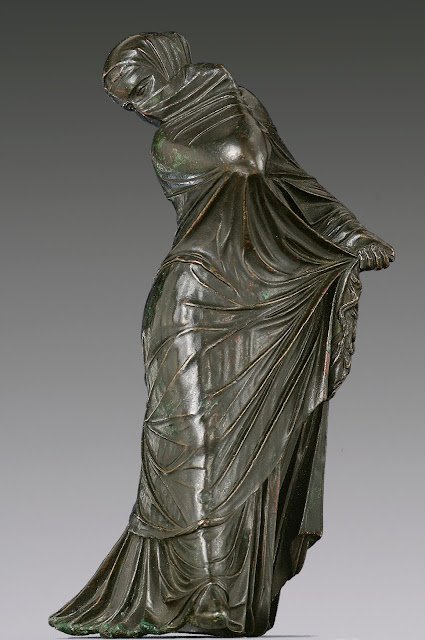 |
| Bronze Statuette Veiled and masked dancer 3rd-2nd century BC Hellenistic Alexandria Metropolitan Museum of Art |
 |
| Bronze Statuette Veiled and masked dancer 3rd-2nd century BC Hellenistic Alexandria Metropolitan Museum of Art |
 |
| Bronze Statuette Veiled and masked dancer 3rd-2nd century BC Hellenistic Alexandria Metropolitan Museum of Art |
 |
| Bronze Statuette Veiled and masked dancer 3rd-2nd century BC Hellenistic Alexandria Metropolitan Museum of Art |
The bronze dancer above (seen from four different sides) preserves in its way an ephemeral performance with expressive draperies that took place in Alexandria (or that did not take place) more than two thousand years ago. Isadora Duncan fancied that she could revive exactly this ancient allure in the early 20th century by means of her own fluid draperies and inspired limbs.
Below, Dionysos pursues his eternal bride Ariadne around the sides of the deep two-handled drinking-cup or skyphos. Again, there are views of the one object from four different sides. The free-form flourishes under the handles are endowed with the same share of weight and substance as the two mythological figures, pursuer and pursued, in their trance of static motion on the unobstructed sides.
 |
| Terracotta red-figure Skyphos Dionysos pursues Ariadne ca. 470 BC Attic Greece Metropolitan Museum of Art |
 |
| Terracotta red-figure Skyphos Dionysos pursues Ariadne ca. 470 BC Attic Greece Metropolitan Museum of Art |
 |
| Terracotta red-figure Sykphos Dionysos pursues Ariadne ca. 470 BC Attic Greece Metropolitan Museum of Art |
 |
| Terracotta red-figure Skyphos Dionysos pursues Ariadne ca. 470 BC Attic Greece Metropolitan Museum of Art |
 |
| Bronze Cista Winged genii carrying the body of a dead soldier ca. 350-325 BC from the necropolis at Praeneste near Rome Metropolitan Museum of Art |
 |
| Bronze Cista Winged genii carrying the body of a dead soldier ca. 350-325 BC from the necropolis at Praeneste near Rome Metropolitan Museum of Art |
Etruscan and Roman culture produced bronze cista, cylindrical lidded containers used ceremonially in burials to accompany the dead and serve them in the underworld. The cista above, now in the Metropolitan Museum, is engraved over its entire surface with scenes from the Trojan War.
Below, a terracotta hydria or water jar from one of the Greek colonies that spread across Southern Italy in the centuries before the Romans imposed their own hegemony there. The white structure painted on the front of the vesel represents a naiskos or grave shrine resembling a small house. The figures of living mourners are portrayed at the sides in the usual red color. Figures of dead people are whitewashed, like the tomb itself.
 |
| Terracotta red-figure Hydria Tomb scene with naiskos ca. 330-300 BC Greek culture in South Italy Metropolitan Museum of Art |
 |
| Terracotta red-figure Hydria Tomb scene with naiskos ca. 330-300 BC Greek culture in South Italy Metropolitan Museum of Art |
 |
| Terracotta red-figure Hydria Tomb scene with naiskos ca. 330-300 BC Greek culture in South Italy Metropolitan Museum of Art |
 |
| Terracotta red-figure Hydria Tomb scene with naiskos ca. 330-300 BC Greek culture in South Italy Metropolitan Museum of Art |
I am grateful to the Metropolitan Museum of Art for the fine reproductions.